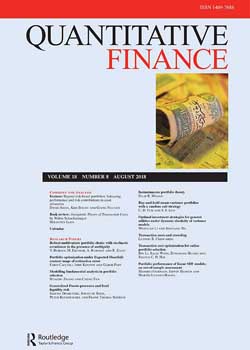
Published by: Taylor & Francis
Editor(s): Jim Gatheral - Baruch College, The City University of New York, USA and Michael Dempster - Centre for Mathematical Sciences, University of Cambridge
The frontiers of finance are shifting rapidly, driven in part by the increasing use of quantitative methods in the field. Quantitative Finance welcomes original research articles that reflect the dynamism of this area. The journal provides an interdisciplinary forum for presenting both theoretical and empirical approaches and offers rapid publication of original new work with high standards of quality. The readership is broad, embracing researchers and practitioners across a range of specialisms and within a variety of organizations. All articles should aim to be of interest to this broad readership.
